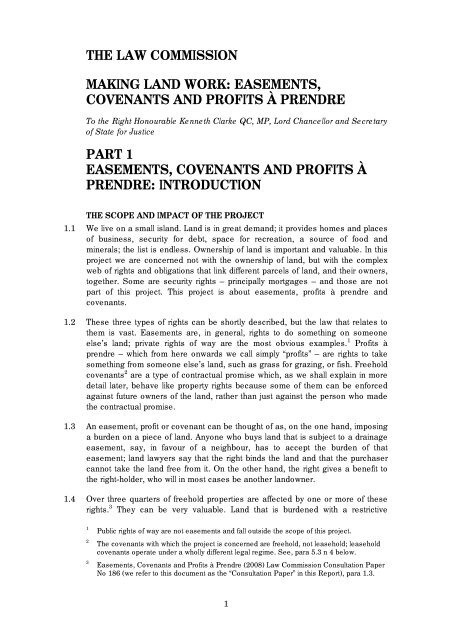Making Land Work: Easements, Covenants and ... - Law Commission
Making Land Work: Easements, Covenants and ... - Law Commission
Making Land Work: Easements, Covenants and ... - Law Commission
You also want an ePaper? Increase the reach of your titles
YUMPU automatically turns print PDFs into web optimized ePapers that Google loves.
THE LAW COMMISSION<br />
MAKING LAND WORK: EASEMENTS,<br />
COVENANTS AND PROFITS À PRENDRE<br />
To the Right Honourable Kenneth Clarke QC, MP, Lord Chancellor <strong>and</strong> Secretary<br />
of State for Justice<br />
PART 1<br />
EASEMENTS, COVENANTS AND PROFITS À<br />
PRENDRE: INTRODUCTION<br />
THE SCOPE AND IMPACT OF THE PROJECT<br />
1.1 We live on a small isl<strong>and</strong>. <strong>L<strong>and</strong></strong> is in great dem<strong>and</strong>; it provides homes <strong>and</strong> places<br />
of business, security for debt, space for recreation, a source of food <strong>and</strong><br />
minerals; the list is endless. Ownership of l<strong>and</strong> is important <strong>and</strong> valuable. In this<br />
project we are concerned not with the ownership of l<strong>and</strong>, but with the complex<br />
web of rights <strong>and</strong> obligations that link different parcels of l<strong>and</strong>, <strong>and</strong> their owners,<br />
together. Some are security rights – principally mortgages – <strong>and</strong> those are not<br />
part of this project. This project is about easements, profits à prendre <strong>and</strong><br />
covenants.<br />
1.2 These three types of rights can be shortly described, but the law that relates to<br />
them is vast. <strong>Easements</strong> are, in general, rights to do something on someone<br />
else’s l<strong>and</strong>; private rights of way are the most obvious examples. 1 Profits à<br />
prendre – which from here onwards we call simply “profits” – are rights to take<br />
something from someone else’s l<strong>and</strong>, such as grass for grazing, or fish. Freehold<br />
covenants 2 are a type of contractual promise which, as we shall explain in more<br />
detail later, behave like property rights because some of them can be enforced<br />
against future owners of the l<strong>and</strong>, rather than just against the person who made<br />
the contractual promise.<br />
1.3 An easement, profit or covenant can be thought of as, on the one h<strong>and</strong>, imposing<br />
a burden on a piece of l<strong>and</strong>. Anyone who buys l<strong>and</strong> that is subject to a drainage<br />
easement, say, in favour of a neighbour, has to accept the burden of that<br />
easement; l<strong>and</strong> lawyers say that the right binds the l<strong>and</strong> <strong>and</strong> that the purchaser<br />
cannot take the l<strong>and</strong> free from it. On the other h<strong>and</strong>, the right gives a benefit to<br />
the right-holder, who will in most cases be another l<strong>and</strong>owner.<br />
1.4 Over three quarters of freehold properties are affected by one or more of these<br />
rights. 3 They can be very valuable. <strong>L<strong>and</strong></strong> that is burdened with a restrictive<br />
1 Public rights of way are not easements <strong>and</strong> fall outside the scope of this project.<br />
2 The covenants with which the project is concerned are freehold, not leasehold; leasehold<br />
covenants operate under a wholly different legal regime. See, para 5.3 n 4 below.<br />
3 <strong>Easements</strong>, <strong>Covenants</strong> <strong>and</strong> Profits à Prendre (2008) <strong>Law</strong> <strong>Commission</strong> Consultation Paper<br />
No 186 (we refer to this document as the “Consultation Paper” in this Report), para 1.3.<br />
1
















